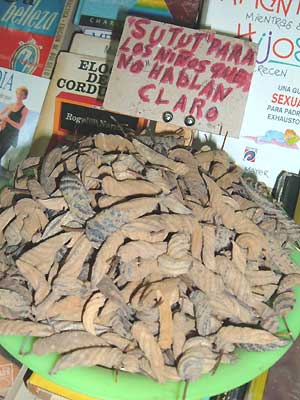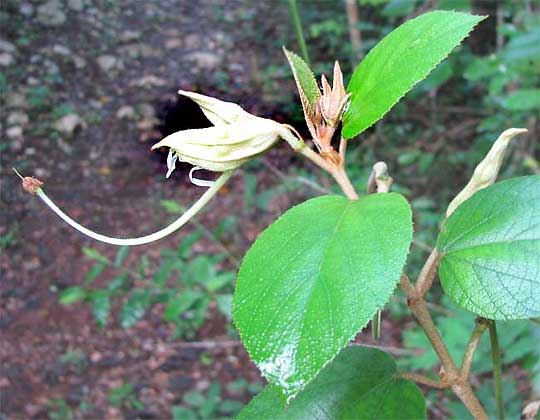Excerpts from Jim Conrad's
Naturalist Newsletter
from the January 13, 2006 issue written at Hacienda San Juan Lizárraga one km east of Telchac Pueblo, Yucatán, México
SU-TUT
The other day Cotting in Pennsylvania sent me a picture she'd taken in Mérida's market. It showed a bowl of fruits looking very much like dried jalapeño peppers dusted with brown powder, except that the fruits were spirally twisted. A hand-printed sign placed in the bowl read "'SU TUT' PARA LOS NIÑOS QUE NO HABLAN CLARO" -- "'Su-tut for children who don't speak clearly." That's Cotting's picture below:

The tough, naturally spiraling fruits are unlike any other fruit in our area, though the bush producing them is distributed throughout much of tropical America. Su-tut is its Maya name; I don't have an English name for it. It's HELICTERES BARUENSIS, a member of the Sterculiaceae, the Cacao Family, in which the native Mexican "Chocolate Tree," Theobroma cacao, also is found. {Sterculiaceae now lumped into Malvaceae, the Hibiscus Family}
I asked Roberto the gardener if he knew Su-tut, and he did, sometimes seeing it when he wanders far from the road looking for firewood. He'd heard that it was medicinal, but he didn't know what it was used for. That night Roberto asked his father and the next day he told me this:
"Su-tut is for children with speech problems," he said. "You put a fruit into the child's mouth, twist it nine times in one direction, then twist it nine times in the other direction, and after you do that for a few weeks the child no longer has problems speaking."
I have seen the placebo effect successfully cure too many illnesses to dwell much about how this cure might work. Moreover, I savor the esthetic value in making the connection between that hard, spiraling fruit, and a kid who can't speak straight. I am glad I have learned to honor Su-tut.
The day after I learned Su-tut's value, Roberto's Maya-speaking father died. The father had known all about Su-tut, the son had known its name but not its value, and I don't believe that any of Roberto's children know the least about either Su-tut or the Maya language that dignifies the plant with its special name.
These days I am feeling with a special poignancy the sadness of the old wisdoms going extinct.
from the October 20, 2008 issue written in Yokdzonot and issued from a ciber in Pisté, Yucatán, México
SU-TUT
Since learning about Su-tut, whenever I've been in the Yucatan scrub I've looked for the fruits and never found them -- until arriving here. Su-tut is common around Yokdzonot, growing weedily along roadsides and flowering robustly, as you can see below:

Helicteres baruensis flowers are unusual-looking affairs. Their calyxes are much enlarged and inflated while their petals are much reduced. Usually it's the other way around. A typical Su-tut blossom at its peak of pollen receptivity appears at the left in the picture. If you paid attention to the hibiscus flower's anatomy last week you probably assume that, as is the case with hibiscus flowers, the long, slender, curved item emerging from the calyx is the staminal tube consisting of the stamens' fused filaments, and that the threadlike style lies inside the tube. That's not what this flower is doing, however.
The long, slender thing is the stalk, or stipe, of the ovary. In other words, instead of the ovary residing like a little egg in the center and bottom of the cuplike calyx and corolla, it's held far beyond the calyx and corolla on a thick, tough stem. The globular mass at the stem's tip consists mostly of the stamens' anthers, and inside the anthers lies the tiny pistil consisting of stigma, style and ovary, the future fruit.
You can see mature fruits dangling on their stalks below:

Who knows why Helicteres thinks it needs its sexual parts and its fruits on such long stalks? If I had to guess, I'd say that it helps seed dissemination. Later the mature fruits turn dark and split open. When wind shakes the branches, the fruits get whipped around more violently if they're on long stalks than if they're sessile on the stem.
Also notice that some fruits spiral one way while others spiral the opposite way. In Nature usually things spiral exclusively one way or another, so this strikes me as odd.
By the way, the Maya here call Su-tut "Su-put," and elsewhere I've heard them referred to as Zu-tut, so that shows how a language can drift from locality to locality.